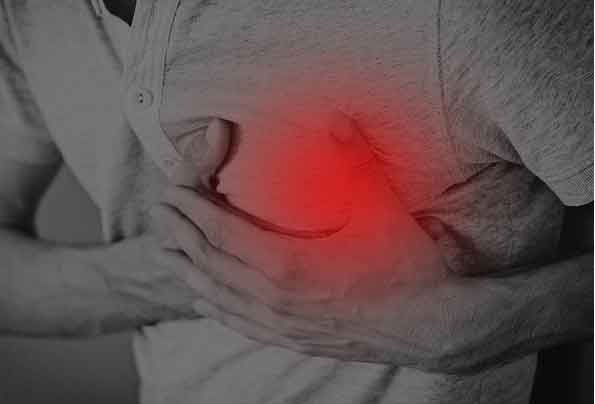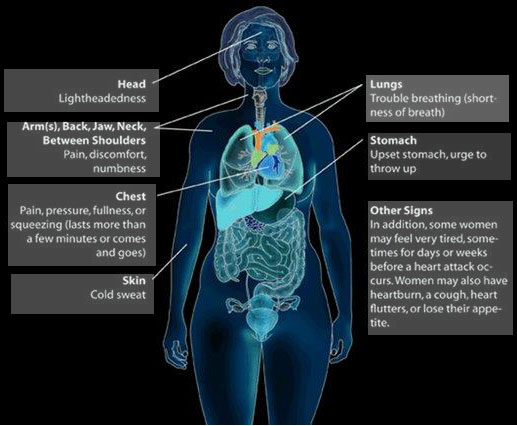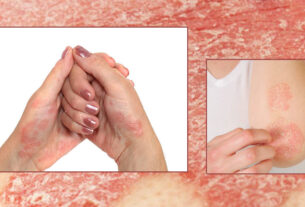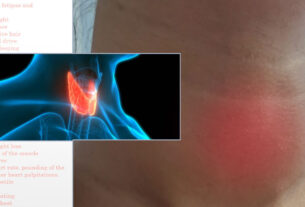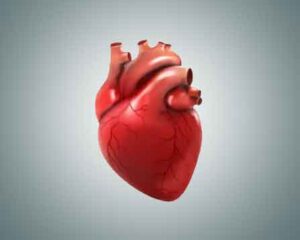 The Heart is an organ about the size of your fist, located between your lungs in the middle of your chest that pumps blood through your body. The Heart is made up of multiple layers of tissue and situated at the center of the circulatory system.
The Heart is an organ about the size of your fist, located between your lungs in the middle of your chest that pumps blood through your body. The Heart is made up of multiple layers of tissue and situated at the center of the circulatory system.
Heart Attack
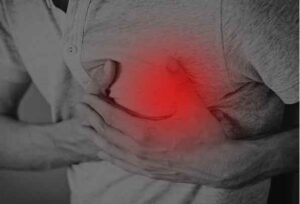 A heart attack is a medical emergency. In simple terms, it is a blockage of blood flow to the heart muscle. Due to the lack of blood, heart tissues lose oxygen and die. The heart has four main arteries that deliver oxygenated blood to the heart muscle. If any of these arteries or its branches becomes blocked suddenly, a portion of the heart is deprived of oxygen and this starvation is called “Cardiac ischemia”. If cardiac ischemia goes for a long time, the heart tissues will die. This condition is called a heart attack or myocardial infarction or normally death of heart muscles.
A heart attack is a medical emergency. In simple terms, it is a blockage of blood flow to the heart muscle. Due to the lack of blood, heart tissues lose oxygen and die. The heart has four main arteries that deliver oxygenated blood to the heart muscle. If any of these arteries or its branches becomes blocked suddenly, a portion of the heart is deprived of oxygen and this starvation is called “Cardiac ischemia”. If cardiac ischemia goes for a long time, the heart tissues will die. This condition is called a heart attack or myocardial infarction or normally death of heart muscles.
Clinical Manifestations
- Severe immobilizing chest pain is not relieved by complete rest and position change or nitrate administration.
- Continuous and un-similar any other pain, it is usually described as heaviness, pressure, tightness, burning, constriction, and crushing.
- Sometimes the pain may spread to the neck, jaw, and arms or the back. It commonly occurs in the early morning hours and usually lasts for 20 minutes or more.
- Excessive sweating and fast heart rate
- Shortness of breath
- Some may not experience severe pain however they may have “discomfort”, weakness, or shortness of breath.
- Women and Men have some similarities in their symptoms
- Patient with diabetics are more likely to experience a silent heart attack
- An older people may experience a significant change in mental status (e.g., confusion), shortness of breath, pulmonary edema, dizziness, or dysthymias.
- Nausea and Vomiting may occur because of vasovagal reflex initiated from the area of the infarcted myocardium
- Fever: The temperature may increase within the first 24 hours up to 100.4 degrees F and occasionally to 102.2 degrees F. The temperature rise may last for as long as 1 week. This increase in temperature is a symptom of the inflammatory process caused by myocardial cell death
- About 25% of all heart attacks may happen without any previous warning signs
Heart attack warning signs
Heart Attack symptoms: MEN VS. WOMEN
| MEN | WOMEN |
|
|
Main Causes
- High blood pressure
- High cholesterol
- Obesity
- Smoking
- Sedentary lifestyle
- Stress
- Diabetes
- Family history of heart disease
- Pneumonia
- Pneumothorax
- Pulmonary edema
- Esophagitis
- GERD
- Great vessel injury
- Excessive intake of drugs
- Severe anxiety
Who is at risk?
- High blood pressure – You are at high risk for a heart attack if you have high blood pressure. Normal blood pressure is around 120/80 mm Hg depending on your age and heath.
- High cholesterol levels – Having high blood cholesterol puts you at greater risk for heart attack.
- Obesity – You are the greater risk if you are obese. You may be able to lower your body fat by making changes in your diet and doing fitness exercises
- High Triglyceride levels- Triglycerides are a type of fat that clog up your arteries which results in myocardial infarction
- High Blood sugar levels- High blood sugar level may damage blood vessels and result in Heart attacks
- Smoking – Smoking tobacco products increases your chances of heart attack
- Age – Men having a high risk of heart attack compared with women. Men are at high risk after 45 years of age while women after 55 years
- Family history – Person with a family history of a Heart attack having a high risk
Complications
- Dysrhythmias – The most common complication after an MI (Myocardial Infarction) is dysrhythmias, which are present in 80% of MI patients. Dysrhythmias are the most common cause of death in patients in the pre-hospital period. Dysrhythmias are a result of any condition that affects the myocardial cell’s sensitivity to nerve impulses.
- Heart Failure – Heart failure is a complication that as a result of when the pumping power of the heart has diminished
- Cardiogenic Shock – Cardiogenic shock occurs when less adequate oxygen and nutrients are supplied to the tissues because of severe left ventricular failure
- Papillary Muscle dysfunction – It occurs if the infarcted area includes or is adjacent to the papillary muscle that attaches to the mitral valve
- Ventricular Aneurysm – It occurs when the infarcted myocardial wall becomes thinned and bulges out during contraction. The patient with a ventricular aneurysm may experience refractory Heart Failure, dysrhythmias, and angina.
- Dressler syndrome – Dressler syndrome is characterized by pericarditis with effusion and fever that develops 4 to 6 weeks after MI.
Treatment
Immediate Treatment
- Provide CPR and to keep the patient alive.
- Immediate hospitalization.
- Treat life-threatening problems.
- Remove pain and suffering.
- Preserve as much myocardium as possible by the dissolution of Blood Clot or Thrombus, Blocking Lumen of Coronary Artery.
Heart attack requires immediate treatment. In most cases, a minimally invasive procedure called angioplasty is used to unblock the arteries that provide blood to the heart. During an angioplasty, the doctor will insert a long, thin catheter through your artery to reach the
blockage. They will then inflate a small balloon attached to the catheter to reopen the artery, allowing blood flow to resume, and place a small, mesh tube called a stent at the site of the blockage. The stent can block the artery from closing again.
Main Drugs used to treat Heart attack
- Anticoagulants – It reduced the clotting capacity of the blood. It helps to block harmful clots from forming in the blood vessels
- Antiplatelet – Aspirin is a commonly used antiplatelet agent. It aids in blood clots from forming by preventing blood platelets from sticking together. Helps prevent clotting of blood in patients who have had an ischemic stroke, heart attack, unstable
angina, and other forms of cardiac disease - Angiotensin-Converting Enzyme (ACE) inhibitors – Expands blood vessels and decrease resistance by reducing the levels of angiotensin II
- Angiotensin II Receptor Blockers (or Inhibitors)
- (Also known as ARBs)– Used to treat or improve symptoms of cardiovascular conditions including high blood pressure and heart failure.
Commonly prescribed include:
Azilsartan
Candesartan
Irbesartan
Losartan
Olmesartan
Telmisartan
- Angiotensin Receptor-Neprilysin Inhibitors (ARNIs)- The enzyme called Neprilysin that breaks down natural substances in the body that open narrowed arteries. By reducing the effect of neprilysin, it enhances the effects of these substances and improves artery opening and blood flow decreases sodium (salt) retention and decreases strain on the heart.
Commonly prescribed include:
Sacubitril/valsartan (Entresto)
- Beta-Blockers ( Beta-Adrenergic Blocking Agents)
Commonly prescribed include:
Acebutolol (Sectral)
Atenolol (Tenormin)
Betaxolol (Kerlone)
Bisoprolol/hydrochlorothiazide (Ziac)
Bisoprolol (Zebeta)
Metoprolol (Lopressor, Toprol XL)
Nadolol (Corgard)
Propranolol (Inderal)
Sotalol (Betapace) - Combined Alpha and Beta-Blockers– Combined alpha and beta-blockers are mostly recommended to treat high BP and heart failure.
Commonly prescribed include
Carvedilol
Labetalol hydrochloride
- Calcium Channel Blockers- (Calcium Antagonists/Calcium Blockers)
Commonly prescribed include:
Amlodipine
Diltiazem
Felodipine
Nifedipine
Nimodipine
Nisoldipine - Combination statin and cholesterol absorption inhibitors:
Ezetimibe/Simvastatin – Various medications can lower blood cholesterol levels, but drugs other than statins are usually used for patients whose statins are not productive or who have serious side effects from statin therapy. They work in the body in multiple ways.
Prevention
Some preventive measures to overcome the risk of myocardial infarction are as follows:
- Quit smoking
- Eat a balanced and healthy diet.
- Stay active: get plenty of exercises.
- Get plenty of good quality sleep.
- Keep diabetes under control.
- Keep alcohol intake down.
- Maintain blood cholesterol at optimum levels.
- Keep blood pressure in control.
- Maintain a healthy body weight.
- Avoid stress and learn how to manage stress.
